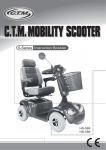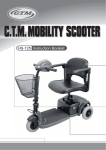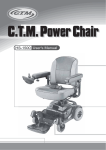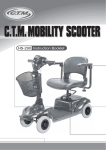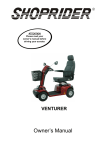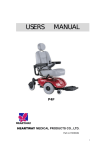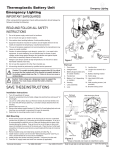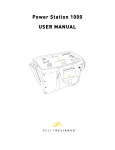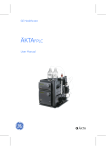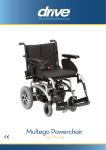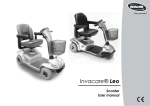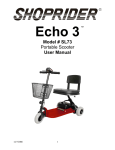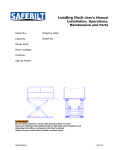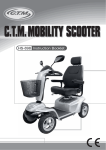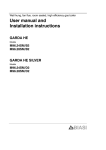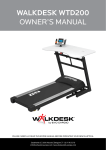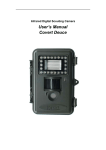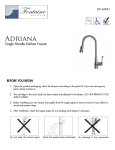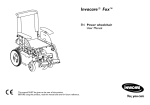Download 588-589-00a [Converted]
Transcript
Horizon Scooter Horizon User Manual Horizon User Manual TABLE OF CONTENTS Introduction --------------------------------------------------------------1 Important Precautions -------------------------------------------------2 Electromagnetic Interference and Warnings ----------------------3 Identification of Parts --------------------------------------------------6 Operating Your Scooter ---------------------------------------------10 Disassembling Your Scooter ---------------------------------------12 Re-assembling Your Scooter ---------------------------------------15 Charging the Batteries ----------------------------------------------16 Care and Maintenance ----------------------------------------------18 Troubleshooting -------------------------------------------------------19 Technical Specifications --------------------------------------------21 Horizon User Manual INTRODUCTION Thank you and congratulations on purchasing your new Invacare Mobility Scooter. It is designed to provide you with transportation indoors and outdoors. We pride ourselves on providing safe and comfortable products. Our goal is to ensure your complete satisfaction with our product. We are certain that you will enjoy your Invacare mobility scooter. Please read and observe all warnings and instructions given in the owner's manual before operating this scooter. Also, retain this booklet for future reference. If you have any questions, please contact your local dealer or: For your local distributor Phone: 0800 770 220 www.invacare.co.nz Invacare® New Zealand 4 Westfield Place, PO Box 62 124, Mt Wellington, Auckland New Zealand Freephone: 0508 468 222 FreeFax: 0508 807 788 Email: [email protected] 1 Horizon User Manual IMPORTANT PRECAUTIONS •Only one person at a time can ride a Invacare Mobility Scooter. •Maximum load is 135 kg / 300 lbs. •Turn the key off before getting on or off your scooter. •Always drive carefully with your feet on the floorboard and be aware of others in your area. •Always use pedestrian crossings where possible. Take extreme care crossing roads. •Do not drive on slopes exceeding 12 degrees, and take extreme care when turning on slopes. •Do not use full power when turning sharp corners. •Do not drive the scooter unless the seat and the tiller are locked and secured in the driving position. •Do not use the scooter if the rear anti-tip wheels are damaged or removed. •Take great care and use low speeds for backing up, riding downhill, over uneven surfaces and kerb climbing. •The scooter may not operate well in high humidity. •Never put your scooter in neutral when stopping on slopes. •Follow all traffic laws when you ride in the vicinity of public roads. •It is NOT recommended to use your scooter in wet environments as it may cause damage. Electronic equipment damaged by any liquid form is not covered under the warranty. 2 Horizon User Manual ELECTROMAGNETIC INTERFERENCE AND WARNINGS CAUTION: It is very important that you read this information regarding the possible effects of Electromagnetic Interference on your motorized scooter. Powered wheelchairs and motorized scooters may be susceptible to electromagnetic interference (EMI), which is interfering electromagnetic energy (EM) emitted from sources such as radio stations, TV stations, amateur radio (HAM) transmitters, two-way radios, and cellular phones. The interference (from radio wave sources) can cause the motorized scooter to release its brakes, move by itself, or move in unintended directions. It can also permanently damage the motorized scooter control system. The intensity of the interfering EM energy can be measured in volts per meter (V/m). Each motorized scooter can resist EMI up to a certain intensity. This is called its "immunity level." The higher the immunity level, the greater the protection will be. At this time, current technology is capable of achieving at least a 20 V/m immunity level, which would provide useful protection from the more common sources of radiated EMI. The immunity level of this motorized scooter model is 10 v/m. There are a number of sources of relatively intense electromagnetic fields in the everyday environment. Some of these sources are obvious and easy to avoid. Others are not apparent and exposure is unavoidable. However, we believe that by following the warnings listed below, your risk to EMI will be minimized. The sources of radiated EMI can be broadly classified into three types: 1.Hand-held portable transceivers (transmitters-receivers) with the antenna mounted directly on the transmitting unit. Examples include: citizens band (CB) radios, "walkie talkie," security, fire, and police transceivers, cellular telephones, and other personal communication devices. Some cellular telephones and similar devices transmit signals while they are ON, even when not being used. 2.Medium-range mobile transceivers, such as those used in police cars, fire trucks, ambulances, and taxis. These usually have the antenna mounted on the outside of the vehicle. 3 Horizon User Manual 3.Long-range transmitters and transceivers such as commercial broadcast transmitters (radio and TV broadcast antenna towers) and amateur (HAM) radios. Other types of hand-held devices, such as cordless phones, laptop computers, AM/FM radios, TV sets, CD players, and cassette players, and small appliances, such as electric shavers and hair dryers, so far as we know, are not likely to cause EMI problems to your motorized scooter. Motorized Scooter Electromagnetic Interference: Because EM energy rapidly becomes more intense as one moves closer to the transmitting antenna (source), the EM fields from hand-held radio wave sources (transceivers) are of special concern. It is possible to unintentionally bring high levels of EM energy very close to the motorized scooter control system while using these devices. This can affect motorized scooter movement and braking. Therefore, the warnings listed below are recommended to prevent possible interference with the control system of the motorized scooter. Warnings: Electromagnetic interference (EMI) from sources such as radio and TV stations, amateur radio (HAM) transmitters, two-way radios, and cellular phones can affect motorized scooters. Following the warnings listed below should reduce the chance of unintended brake release or motorized scooter movement, which could result in serious injury. 1.Do not operate hand-held transceivers (transmitters-receivers), such as citizens band (CB) radios, or turn ON personal communication devices, such as cellular phones, while the motorized scooter is turned ON; 2.Be aware of nearby transmitters, such as radio or TV stations, and try to avoid coming close to them; 3.If unintended movement or brake release occurs, turn the motorized scooter OFF as soon as it is safe; 4 Horizon User Manual 4.Be aware that adding accessories or components, or modifying the motorized scooter, may make it more susceptible to EMI; and. There is no easy way to evaluate their effect on the overall immunity of the motorized scooter. 5.Report all incidents of unintended movement or brake release to the distributor listed on the inside front cover of this manual. Note whether there is a source of EMI nearby. Important Information: 1.20 volts per meter (V/m) is a generally achievable and useful immunity level against EMI (as of May 1994). The higher the level, the greater the protection. 2.The immunity level of this product is at least 20/Vm. 5 Horizon User Manual IDENTIFICATION OF PARTS Before attempting to drive this scooter on your own, it is important that you familiarize yourself with the controls and how they operate. Tiller Angle Adjustment Rearview Mirror Mid-Back W/Headrest Swivel Seat Delta Handle Bar Tilting Armrest Front Basket Seat Rotation Lever Side Reflectors Optical Headlights & Turn Signals Seat Sliding Lever 11" Front and Rear Wheels Figure 1 - Horizon Front View Power Reserve Indicator Hazard Light Button Speed Control Knob Horn Button Armrest Width Adjustment Thumbscrews Freewheeling Lever Storage Cover Left Turn Signal Button Headlight Button Rear Turn Signal and Tail Lights Right Turn Signal Button Thumb Lever Figure 2 Horizon TOP CONTROL PANEL Anti-Tip Wheels Figure 3 Horizon BACK VIEW 6 Horizon User Manual Function Of Parts: •MAIN SWITCH (A) (See Fig. 4) 1.Turn the key clockwise to ON to switch power on status. 2.Turn the key counterclockwise to OFF to switch power off status. •SPEED CONTROL KNOB (B) (See Fig. 5) 1.Turn the speed control knob clockwise for faster speed. 2.Turn the speed control knob counterclockwise for slower speed. (A) (B) Figure 4 Figure 5 •TOP CONTROL PANEL BUTTONS (See Fig. 6) 1.Left/Right Turn Signal-Press Right Turn Signal (1) button for turning right, press Left Turn Signal (2) button for turning left. 2.Hazard Light Button-Press Hazard Light Button (3) to switch on Hazard Light, press the button again to switch off the Hazard Light. 3.Horn Button-Press Horn Button (4) will buzz warning sound, stop horning by release it. 4.Power Reserve Indicator (5)-Displays batteries electricity carrying capacity. 5.Headlight Button-Press Headlight Button (6), headlight will light up. •THUMB LEVER (See Fig. 7) 1.Lightly push on the right side thumb lever (C) to moving forward. 2.Lightly push on the left side thumb lever (D) to moving backward. 3.Release the thumb lever and the powered scooter will quickly slow down to an immediate stop and the brake will engage. (5) (3) (4) (1) (2) Figure 6 (6) (D) Figure 7 (C) 7 Horizon User Manual •ARMREST ADJUSTMENT (See Fig. 8) 1.Release Thumbscrew (E), to adjust the armrest's width; tighten to lock in the comfortable desired position. •ARM PAD ADJUSTMENT (See Fig. 9) 1.Adjust the handrail bolt's (F) height, to control the armrest's horizontal angle. •SEAT ADJUSTMENT (See Fig. 10) 1.Pull the seat rotation lever (G) up to adjust seat's turning angle, also can lift up the seat . 2.Pull the seat sliding lever (H) up to adjust the seat to either go forward or backward to an appropriate position. (F) (E) Figure 9 Figure 8 (I) (H) (G) Figure 10 Figure 11 •FREE-WHEELING LEVER (See Fig. 11) 1.Before driving, to engage the free-wheeling lever (I) by push the lever downward. 2.While stopping or system malfunction could not operate the scooter, by pulling the free-wheeling lever then the scooter can be moved manually. Its extremely dangerous to drive on the scooter when the free-wheeling lever is disengaged and travelling down a slope. The operator must ensure that the free-wheeling lever is engaged prior to driving. 8 Horizon User Manual •CIRCUIT BREAKER (See Fig. 12) 1.If the scooter's circuit system malfunction or over loaded, the circuit breaker (J) will automatically switch off the power to ensure safety. 2.After automatically power switch off by press the circuit breaker can be reset. •TILLER ANGLE ADJUSTMENT (See Fig. 13) 1.To adjust tiller angle by pushing down the tiller angle adjustment (K). Objects should not be hung from the tiller assembly. (J) (K) Figure 12 Figure 13 9 Horizon User Manual OPERATING YOUR SCOOTER Before beginning your journey with your new scooter, make sure that the scooter is on a level surface and clear of any obstacles. Although your scooter is able to climb slopes it is safer to practice on a leveled surface. You can make the following adjustments to increase your comfort when driving: •adjust the seat height and location. •adjust the armrest width. •adjust the tiller to a comfortable position. 1.Before operating your scooter, check the following: •the free-wheeling lever is engaged. •the speed dial is at the picture of the turtle. 2.Sit on the scooter and turn on the key. All battery gauge LED lights should be lit. The self-diagnostic warning light should not be blinking. 3.When your hands rest comfortably on the handle bar, the thumb control levers should be within reach. The right lever moves the scooter forward; the left one moves it in reverse. When you release the thumb lever, the scooter will stop. This scooter has an automatic braking system. Release the thumb control and the brakes will engage. 4.Steer the scooter by turning the whole tiller in the direction you want to go. 5.Practice driving where there are no obstacles. Start at the slowest speed and drive forward and backward; make some turns. As you get more comfortable you can increase the speed by turning the speed dial toward the picture of the rabbit. 6.If only two-battery gauge LED lights are lit, you should plan to recharge the batteries very soon. 7.If the scooter stops and does not function, locate the circuit breaker (L) in the storage area. Push it and try the scooter again. 8.When you are finished riding, turn off the key before getting off. 9.If you are finished riding for the day, immediately recharge the batteries. See CHARGING THE BATTERIES on page 15. Figure 14 (L) 10 Horizon User Manual Keep in mind these rules: •Release the thumb levers and allow the scooter to stop completely before changing from forward to reverse, or reverse to forward. •When turning a corner, swing the front wheels wide, because the back wheels will turn more tightly. •Use the scooter only where it would be safe to walk. •Use low speeds for reverse, downhill, ramps, kerbs, or uneven surfaces. Other Operating Information: Hill Climbing:You may need to use a higher speed going up on slopes. For a higher speed, set the speed control knob in the proximity of the rabbit. Down Slopes:To proceed down steep slopes slowly, set the speed control in the proximity of the turtle. This enables driver control, as the closer the speed control is set toward the turtle, the slower the scooter will travel. However, this scooter will not self accelerate down hills due to the automatic braking taking effect should you attempt to drive too fast. Kerb Climbing:Approach slowly at right angles to the kerb. A slight angle is permissible with a 4-wheel scooter. Do not attempt kerb climbing greater than a 50mm kerb. If the Self-Diagnostic Warning Lights start to blink, identify the problem from the chart on page 18 and take action. Vertical limit approach approximately : 5cm Acceptable gap width approximately : 22cm When driving, proceed straight forward slowly pass through the gap. Figure 15 Figure 16 If the scooter breaks down and must be moved, get off the scooter, pull the free-wheeling lever, move the scooter slowly to a safe location, and push the free-wheeling lever back downward to engage. As a safety feature, an automatic speed reducer engages if the scooter is pushed quickly when the Free-wheeling lever is disengaged. This standard feature is specifically created for down slopes. 11 Horizon User Manual DISASSEMBLING YOUR SCOOTER Taking apart your scooter enables you to save space when keeping it in storage or to carry it along in your vehicle when going away from home. Having the scooter disassembled is easier than ever since no tools are required. Please follow these steps Remove the seat by pull the Seat Rotation Lever (M) up and then lift off. (See Fig. 17) Remove the Free-wheeling Lever Knob (N). (See Fig. 18) Life up the Storage Cover (O). (See Fig. 19) and detach the Rear Lighting Wiring Harnesses (P). (See Fig. 20) Remove the Rear Shroud (Q) gently which is held by Velcro.(See Fig. 21) (N) (M) Figure 17 Figure 18 (O) (P) Figure 19 Figure 20 (Q) Figure 21 12 Horizon User Manual Detach the Main Wiring Harnesse (R) from the scooter. (See Fig. 22) Unstrap the Velcro Band (S) that holds the batteries. (See Fig. 23) (S) (R) Figure 22 Figure 23 Unplug both Battery Cables (T) and remove the Batteries (U).(See Fig. 24 & 25) (U) (T) Figure 24 Figure 25 Detach the front and rear sections by holding the Seat Post (V) with one hand and the other hand pushing the release lever to the rear of the scooter. Lift the seat post to separate the Front Frame Assembly (W) from the rear frame assembly. (See Fig. 26) Disassemble Front Basket (X). (See Fig. 27) (V) Figure 26 (W) (X) Figure 27 13 Horizon User Manual Push down the Tiller Angle Adjustment (Y) to fold the tiller in a lower position. (See Fig. 28) Once all the parts have been disassembled, you are now able to put the pieces in storage or in a vehicle for transportation. (See Fig. 29) (Y) Figure 28 Figure 29 14 Horizon User Manual RE-ASSEMBLING YOUR SCOOTER To assemble the scooter, you can repeat the disassembly directions in reverse. Abbreviated directions are given below. Refer to the figures on pages 12-13 to locate the parts. 1.Using the tiller angle adjustment, unfold the tiller in an upright position. Place the front basket on the tiller. 2.Hold the seat post and align the Curved Locking Brackets (Z) on the front frame assembly with the bar on the rear frame assembly. (Z) Figure 30 3.While holding the seat post, slowly pivot the rear frame assemby forward until the release lever locks. 4.Attach the main wire harness. 5.Place the two batteries and use the Velcro strap to secure them in place. 6.Attach the battery cable plugs. 7.Place the rear shroud on. 8.Attach all rear lighting harnesses. 9.Place the storage cover on. 10.Place the free-wheeling lever knob. 11.Install the seat by pulling the seat rotation lever up to allow the seat to drop into the locked position. 15 Horizon User Manual CHARGING THE BATTERIES Your Invacare scooter uses two 12V/50Ah rechargeable batteries and one 24V/5A charger. Batteries must be charged before using the scooter for the first time and should be recharged after each day's use. Be sure the power switch is in the OFF position and the free-wheeling lever is in the engaged position. 1.Insert the Battery Charger Output Terminal (A) into the Scooter Charger Port (B). (B) (A) Figure 31 2.Plug the other end of the power cable into a standard electrical wall outlet. Ensure voltage switch on battery charger is correct in 115V or 230V. Do not place the battery charger near areas that there may be a risk of fire. 3.The Battery Charger Light (C) will normally be amber at this point. (C) Figure 32 4.Allow to charge until the battery charger light turns green. 5.After the light turns green, turn off the switch. Then unplug the battery charger from the scooter and wall outlet. 16 Horizon User Manual 6.If at any time the battery charger light flashes green over 40 minutes, this indicates an abnormal charging has occurred. You should check that: •charger plugs are correctly positioned •fuse is not burned out •the scooter is turned off •if none of these is a problem, contact your authorized dealer. The time needed to recharge will vary depending on the depletion of the batteries. Charging for longer than necessary will not harm the batteries. They cannot be overcharged. Keep in mind these rules: •Fully charge batteries at least once a month, more if you use the scooter regularly. Charge after each trip exceeding 3 kilometers / 1.86 miles. •If storing your scooter for some time (one month or more) make sure that the batteries are fully charged, and on returning, charge them again before using the scooter. Batteries will only give the maximum performance after the scooter has been used, and the batteries have been recharged up to 10 times. For safety, please follow the guidelines below. 1.DO NOT use the charger if the power cord is damaged. 2.DO NOT use an extension cord when charging your batteries. A risk of fire and/or electric shock could be encountered. 3.DO NOT take apart the charger, as this will void the warranty. 17 Horizon User Manual CARE AND MAINTENANCE Taking care of your scooter will keep it in top-notch condition. It is recommended that you have your dealer to provide preventative maintenance service of your scooter on a regularly basis. Here are a few maintenance guidelines: BODY COVER: If your scooter is dirty, use a damp or lightly soapy cloth to wipe it down. Do not use running water to wash or rinse the scooter in order to protect the electrical parts. Polish with an automotive liquid polish. SEAT AND ARMREST: Using a damp cloth helps clean the upholstery. Please note that using the scooter outdoors can lead to sun damage of the upholstery material. Since this is a normal wear and tear condition, it is not covered under the warranty. An authorized dealer should do all maintenance and repair of your scooter that relates to electronics, batteries, motor parts, and tires. Also between uses, your scooter is best stored in a dry location at room temperature. 18 Horizon User Manual TROUBLESHOOTING To check the Self-Diagnostic Warning Light, turn on the key and count the number of flashes. Flash Code/Fault Impact on Scooter Notes 1. Battery needs recharging Will drive Battery charge is running Iow. Recharge the batteries as soon as possible. 2. Battery voltage too Iow Drive inhibited Battery charge is empty. Recharge the batteries. If the scooter is left off for a few minutes, battery charge might recover enough to allow driving for a short time. Drive inhibited Battery charge is too high. If a charger is plugged in, unplug it or turn the Charge/Run switch to Run. Scooters powered by RHINO charge the batteries when travelling down slopes or decelerating. Excessive charging in this manner can cause this fault. Turn the scooter power off then on again. If necessary, reduce speed when descending the slope. Drive inhibited The scooter has drawn too much current for too long, possibly because the motor has been over-worked, jammed or stalled. Turn the scooter power off, leave for a few minutes, and then turn the power back on again. The controller has detected a shorted motor. Check the loom for shorts and check the motor. Contact your service agent. Drive inhibited Check that the park-brake release lever is in the engaged position. Check that the motor/ park-brake connector is plugged in firmly. The park-brake coil or wiring is fauly. Check the park brake and wiring for open or short circuits If necessary, unplug the motor/park-brake connector and check that all four pins are in the correct position. If this flash code does not appear until the throttle has been moved out of neutral, check for a short in the park-brake circuit. If this flash code appears at power-up, check for an open circuit in the park-brake circuit. Contact your service agent. 6. Out of neutral at power-up Drive inhibited Thumb lever not in neutral position when turning key switch on. Return Thumb lever to neutral, turn power off, and back on again. Throttle may need to be re-calibrated (see Section 4.2.3). Check throttle wiring. 7. Speed VR error Drive inhibited Thumb lever or its wiring is faulty. Check for open or short circuits. Thumb lever may not be correctly set up. Contact your service agent. 8. Motor volts error Drive inhibited The motor or its wiring is faulty. Check for open or shot circuits. Contact your service agent. 9. Other internal errors Drive inhibited Contact your service agent. 3. Battery voltage too high 4. Current limit time-out 5. Brake fault 19 Horizon User Manual Other Problems: •Scooter will not move when the key is turned on: 1.Check the power reserve indicator on the control panel. All the LED lights should be on. 2.Check the Self-Diagnostic Warning Light. It should be steady. If it is flashing, see chart on page 18 for problem identification. 3.Check all electrical connections to be sure they are tight. 4.If none of these correct the problem, contact your authorized dealer. •If you have charged your scooter for over 10 hours and the light on the charger does not change to green, then please contact your authorized dealer. Please note that your scooter is equipped with a controller that constantly checks the drive system for a safe and enjoyable ride. If an error occurs, the control panel will provide you an indication of the problem by way of blinking lights. 20 Horizon User Manual TECHNICAL SPECIFICATIONS SPECIFICATIONS Horizon Challenger Overall Length 1290 mm / 51" 1290 mm / 51" Overall Width 620 mm / 24" 625 mm / 25" Overall Height 1140 mm / 45" 1150 mm / 45" Wheels: Front 290 mm / 11" Solid 290 mm / 11" Solid Wheels: Rear 290 mm / 11" Solid 290 mm / 11" Solid Weight without Batteries 65 kg / 143 Ibs. 65 kg / 143 Ibs. Max. Speed 8 kmph / 5 mph 12 kmph / 8 mph Weight Capacity 135 kg / 300 Ibs. 135 kg / 300 Ibs. Ground Clearance 75 mm / 3" 87 mm / 3.4" Grade Climbable 12 degree 12 degree Kerb Climbing 50 mm / 2" 50 mm / 2" Turning Radius 1565 mm / 62" 1565 mm / 62" Front & Rear Front & Rear Electro-Mechanical Electro-Mechanical Suspension Brake Seat Type Premium Upholstery Mid-back with Headrest Swivel Seat Width 455 mm / 18" 455 mm / 18" Motor Size 500W, 3200 r.p.m. 700W, 5900 r.p.m. (2) 12V. 50Ah (2) 12V. 50Ah Battery Weight 31.26kg / 69 Ibs. total 31.26kg / 69 Ibs. total Travel Range Up to 40 km / 25 Miles Up to 40 km / 25 Miles DC 24V / 5 Amp DC 24V / 5 Amp Battery Size Battery Charger Electronics On/Off Key Switch, Battery Level Indicator, Speed Control Knob *Subject to change without notice. 21























